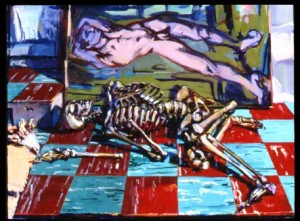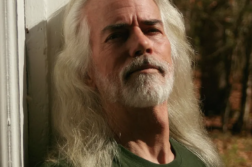REGULAR visitors to Provincetown may know Larry Collins as the cordial and knowledgeable man behind the counter at Larry Collins Fine Art, the gallery that he’s directed at the West End of Commercial Street since 2004. Browsing through his collection of photographs, paintings, artifacts, and memorabilia—including works by such renowned artists as James Bidgood, Mike Disfarmer, Damien Hirst, and Wilhelm von Glöeden—it quickly becomes clear that Collins’ curatorial scrutiny is sharp, studied, and eclectic.
Guests may not always be aware, however, that Collins himself has been working industriously as a painter and photographer for the past five decades, quietly garnering accolades and distinctions along the way. His painterly style is both vibrant and pensive, inspired by postimpressionists like Van Gogh, Gauguin, and  Cézanne, as well as expressionists like Ernst Ludwig Kirchner and abstract expressionists like Willem de Kooning. He has also earned a following for his distinctive, classically influenced drawings of the male form. Collins’ photography is more austere but no less emotional: his most famous photographs include many resonant images taken during his time in Vietnam, where he served as a soldier in the late 1960’s. His artworks and books have been acquired by a number of major institutions, including the Worcester Art Museum, New York Public Library, Boston Public Library, British Library, and the library collections at Harvard, Yale, Stanford, Princeton, and New York’s Museum of Modern Art.
Cézanne, as well as expressionists like Ernst Ludwig Kirchner and abstract expressionists like Willem de Kooning. He has also earned a following for his distinctive, classically influenced drawings of the male form. Collins’ photography is more austere but no less emotional: his most famous photographs include many resonant images taken during his time in Vietnam, where he served as a soldier in the late 1960’s. His artworks and books have been acquired by a number of major institutions, including the Worcester Art Museum, New York Public Library, Boston Public Library, British Library, and the library collections at Harvard, Yale, Stanford, Princeton, and New York’s Museum of Modern Art.
Born in 1945 in Spokane, Washington, Collins was raised in Oklahoma, where he exhibited his work to early acclaim at age seventeen when Dorothy Miller, the legendary former curator of collections at MoMA, selected one of his paintings to be part of a regional show at the Oklahoma Art Center in 1962. Collins received a BFA in 1967 from the University of Oklahoma and an MFA in 1980 from Massachusetts College of Art, where he also taught in the 1980’s and 90’s. Since 1993, Collins has lived and worked in Provincetown, and from 1999 to 2004, he was director of Vintage Photography in the Driskel Gallery at Provincetown’s Schoolhouse Center. Earlier this year, a career retrospective of his art, “Larry R. Collins: Finding Light,” was exhibited at the Provincetown Art Association and Museum.
Recently I talked with Collins about his life and work at his studio in Provincetown.
Jason Roush: You’ve worked as a visual artist from a very young age. Why were you drawn to this particular mode of expression?
Larry Collins: I began painting when I was thirteen. My first picture was of two swordfish fighting. When I got to high school, my art teacher introduced me to Van Gogh and the abstract expressionists. I took to this expressionist mode immediately and began using it as my visual language. I was quiet and withdrawn. I remember feeling that I was putting out messages to other people through my paintings, without really having to talk to them or get close to them. Early on I learned the concept that the form itself may actually be the subject of an artwork, or that the content may wholly inhabit that form.
I started taking photographs when I was in the Army as a soldier in Vietnam. I took a lot of pictures of my fellow soldiers, thinking I would use them as source material for paintings when I returned home. Instead, I put my slides and negatives in a box under the bed for thirty years. Nobody asked to see them anyway, and all of us veterans at that time learned to hide the fact that we had been soldiers in Vietnam. When I decided to print a few of these images for exhibition in the 1990’s, I was surprised by how much they looked like my paintings: dark, moody, and psychological. A photographer friend of mine told me they were beautiful and important, and that they needed to be seen by other people. When I exhibited them, the response was phenomenal.
JR: You and I have spoken before about the idea of the “gay artist” and gay sensibility. Do you feel that this identity serves any useful political, social, or æsthetic purpose?
LC: I was a young man in the 1970’s and remember very well the need I felt to define my own identity as a gay man, to search history for role models, including authors and artists, and to come together with gay brothers and sisters as a political force. Certainly, there have been many efforts to identify and define a homosexual or gay sensibility. I’m thinking of Susan Sontag’s 1964 essay “Notes on Camp,” in which she attempts to describe an æsthetics of irony and opposition, one that resists analysis.
However laudable the reasons may be for the attempts to define or promote the gay artist, gay art, or a gay sensibility—and however illuminating or clarifying—it seems to me that these efforts are basically unsupportable and bound to fail. The picture that is drawn is of an artist whose art is hijacked into service and circumscribed by politics, morality, type, or subject. I don’t personally know any serious, excellent artist today who will submit to being defined as a “gay artist.”
JR: In addition to growing up during an era in which being a gay man was far more difficult, several traumatic experiences have informed your life and your work over time—your military service and also your partner’s death from aids in 1991. How have these events affected you?
LC: I was twenty when I was drafted into the Army, right after graduation from college. Within six months I was carrying a rifle on patrol with my infantry squad in the Vietnam jungle. It was like being in a slow-motion train wreck, knowing that day by day, things were getting worse and worse, and that I was hurtling towards oblivion. Our lives were completely out of our control, not our own anymore, but fate literally reached down and pulled me out of the jungle. A company clerk discovered that I had been to art school and could draw. I actually had to draw something on the spot to prove to him that I could draw, so I sketched a G. I. Joe with a cigarette in his mouth, Bill Mauldin-style—you know, the famous WWII cartoonist. Then I was airlifted right out of the jungle to go back to the newspaper office and do all the artwork for the division in magazines, books, newspapers, whatever. My infantry company was ambushed shortly after I left, and my squad suffered the heaviest casualties.
I was devastated. In the heat of combat, a bond develops among men very quickly, one that’s hard to describe. It sounds like folklore, but it’s true. It’s perhaps like pieces of metal melting together to become connected, forever. All you care about is saving each other. I began drawing imaginary portraits of those guys in my illustrations, but other than that, I had to bury my grief to survive. I learned about the phenomenon of grief many years later when Tom, my partner of seventeen years, died from aids-related complications. Of course, there were parallels between my feelings of helplessness in Vietnam and helplessness in the face of the aids epidemic. The second time, I went through counseling and attended groups where the other guys were going through the same grieving process that I was. It helped me a lot.
JR: How has living in Provincetown for the past seventeen years influenced your life and work?
LC: After my partner died in 1991, I was pretty much lost. I came to Provincetown for two weeks in 1993. I think it was just to get away from the isolation of where I lived alone in rural New Hampshire. As an afterthought, I threw my painting supplies and my French easel into the back of my van, just in case. I did in fact set up my easel outside on the banks of Pilgrim Lake and painted one whole afternoon. For the first time in years since my partner had become ill, I felt relaxed and happy. A few days later I decided to stay for the summer, and I lived in a trailer. I decided this place was for me, and I moved here for good. For the first time in my life, I felt at home.
JR: What have you learned from your collaborative work with writers?
LC: I would have to say that with the books I’ve collaborated on, I’ve become acutely aware that they have a dynamic life of their own after they go out into the world. These books turn up on the Internet, in galleries, in book shops and auctions, in bibliographies, and in over a hundred libraries and museums around the world. I was hired by Bill Morgan, a distinguished writer on the Beat Generation, to produce three limited-edition poetry books with great poets: Allen Ginsberg’s Old Love Story, Lawrence Ferlinghetti’s The Hopper House at Truro, and TOW with Eileen Myles. Each of these collaborations was accomplished by a different method. For the Ginsberg book, I matched up his poem with my paintings. Ferlinghetti’s poem inspired a trip out to Edward Hopper’s house-studio in Truro, where I did drawings to go along with the poetry. Eileen, on the other hand, came to my studio and picked out a group of male nude drawings. A few months later she sent poems that she had written in response to each drawing.
JR: What’s the most important lesson from your artistic career that you regularly apply to other facets of your life?
LC: To paraphrase Ernest Hemingway: “Paint every day the best you can, and always finish what you start.”





